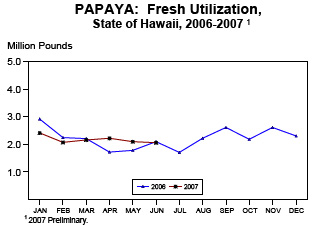Here is the PDF file for the *Hawaii Macadamia Nuts (Final Season Estimates)* Report.
mac-fin071307.pdf
Please visit the website for more information: http://www.nass.usda.gov/hi/
————————————————————-
Contact Information:
Mark E. Hudson, Director
USDA NASS Hawaii Field Office
1421 South King Street
Honolulu, HI 96814-2512
Office: (808) 973-9588 / (800) 804-9514
Fax: (808) 973-2909
————————————————————-
“HAWAII MACADAMIA NUTS” reports are available on our website and also PRINTED twice a year. Subscriptions for PRINTED copies are free to those persons who report agricultural data to NASS (upon request) and available for $2 per year to all others.
Final Season Estimates Higher For 2006-2007 Crop Year
Hawaii?s 2006-07 end-of-season macadamia nut harvest is estimated at 58.0 million pounds net, wet-in-shell, up 4.0 million pounds from last season?s harvest, according to USDA, NASSHawaii Field Office. While not the highest on record, this season?s output matches the previous high set back during the 1997-98 crop year.
Weather for 2006 was mixed. Approximately six weeks of rainfall from late February thru March occurred statewide. For some macadamia nut orchards located in normally drier areas, the rainfall was welcome. However, macadamia nut orchards located in normally wet areas suffered lower output due to disease problems.
Early in the season, one large processor announced it would limit nut purchases from independent growers. Many growers have reported that the lack of an outlet to sell their nuts has been a problem and with lower nut prices, the crop has not been harvested by some growers. Some farmers have reportedly gone into other commodities due to the low prices being paid and the lack of an outlet to sell their nuts. Growers have also related that feral pigs were a problem in some areas. The feral pig problem has increased in some areas; probably due to growers leaving nuts on the ground and providing a food source for pigs which increased survival of offspring, lending itself to more pigs foraging for food.
Crop losses were estimated at 11.0 million pounds or 17 percent of the total crop. Immature nuts ranked as the highest cause of losses at nearly 38 percent followed by koa seed worm damage and moldy or rotten nut losses with 19 percent and 17 percent, respectively. Overall yields averaged 3,867 pounds per acre (net, wet-in-shell), 29 percent higher than the 2005-06 crop year.
Total acreage for 2006-07 decreased 1,300 acres to 17,000 acres while harvested area totaled 15,000 acres, a 3,000 acre decline from last season. The farm price for net, wet in-shell macadamia nuts averaged 67.0 cents per pound, 14.0 cents less than the 2005-06 average.
Crop Losses Measured By Processors Lower
Growers delivered an estimated 65.0 million pounds of macadamia nuts, wet-in-shell, to processors during the 2006-07 season. About 11 percent of the harvest was culled, resulting in 58.0 million pounds net, wet in-shell. The equivalent gross weight of losses, after adjusting for what would be the expected weight before the damage, was 11.0 million pounds, 11 percent less than last season?s revised estimates. Losses from nut immaturity ranked at the top with just under 38 percent of the total losses. Koa seed worm damage was the second most common type of loss at 19 percent, followed by losses from moldy or rotten nuts at 17 percent. Macadamia nut losses shown in this report include only those culled by processors and do not include losses that were culled at the farm before delivery.
U.S Nut Production Up 9 Percent, Value Down 17 Percent
The 2006 U.S nut production is estimated at 1.59 million tons (in-shell basis), 9 percent greater than a year earlier. The almond crop is 953,000 tons, up 23 percent from 2005. Walnut production in 2006, at 346,000 tons, is down 3 percent from the previous year. The pistachio crop is 119,000 tons, 16 percent smaller than 2005. Pecan production in 2006 totals 103,150 tons, a 26 percent drop from 2005. The hazelnut crop, at 43,000 tons, is 56 percent larger than the previous year. Macadamia production is 29,000 tons, up 7 percent.
The 2006 U.S. value of utilized nut production is estimated at 3.45 billion dollars, down 17 percent from the 2005 value. The almond crop is valued at 2.04 billion dollars, 19 percent less than 2005. Walnuts are valued at 554 million dollars, 1 percent less than 2005. Pistachio value for 2006, at 455 million dollars, is 22 percent less than last year. The value of the pecan crop decreased 21 percent to 321 million dollars. Hazelnut value, at 46.4 million dollars, is 25 percent below last year. The macadamia crop is valued at 38.9 million dollars, down 11 percent.
 JUNE FRESH PAPAYA OUTPUT LOWER
JUNE FRESH PAPAYA OUTPUT LOWER To restore Molokai’s contaminated soil, University of Hawaii researchers Alton Arakaki and Qing Li, as well as retired Molokai farmer Lonnie Williams, are rooting for a technique called phytoremediation, which consists of growing plants that can naturally accumulate chemicals from soil.
To restore Molokai’s contaminated soil, University of Hawaii researchers Alton Arakaki and Qing Li, as well as retired Molokai farmer Lonnie Williams, are rooting for a technique called phytoremediation, which consists of growing plants that can naturally accumulate chemicals from soil.